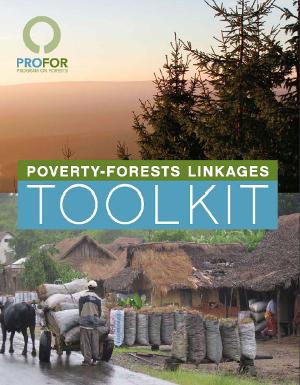data

Share
Related Links
Attachments
Poverty-Forests-NepalCaseStudy_1.pdf
Forests-Poverty-CaseStudyLaoPDR_1.pdf
Authors/Partners
The toolkit had multiple authors including Gill Shepherd and Jill Blockhus. Experts from CIFOR, IUCN, ODI, PROFOR, Winrock International and the World Bank contributed to this work.
Poverty-Forests Linkages Toolkit
CHALLENGE
An estimated 1.2 billion people rely on forests for some part of their livelihoods. However, the importance of forests is often overlooked in national development processes such as poverty reduction strategies due to inadequate evidence documenting how forests sustain the poor.
| Poverty-Forests Linkages Toolkit by PROFOR (Program on Forests) is licensed under a Creative Commons Attribution-Noncommercial 3.0 United States License. Permissions beyond the scope of this license may be obtained by emailing profor@worldbank.org. |
APPROACH
To build better knowledge on this critical relationship, PROFOR developed a “Poverty-Forests Linkages Toolkit” to facilitate relevant data collection and analysis. The Toolkit was created in partnership with CIFOR, IUCN, ODI, and Winrock International, on the basis of case studies in Guinea, India, Indonesia, Lao PDR, Nepal, and Tanzania.
The first draft of the Toolkit was completed in April 2007, and was based on piloting and field testing in three different locations in Indonesian Papua (highlands, lowlands and a mangrove area) and in Tanzania. A consortium of national level organizations led by the International Institute for Economic Development and the Center for International Development and Training carried out further pilots of the Toolkit in four African countries - Cameroon, Ghana, Madagascar and Uganda.
TOOLKIT
What the Poverty-Forest Linkages Toolkit Includes
- A set of rapid appraisal methods to gather information on economic as well as other contributions from forests to households, especially the poor;
- Methods for analyzing field data for the potential role of forests in reducing poverty and vulnerability and policy options for improving the contribution of forests to rural livelihoods;
- Suggestions for how to frame the results so as to be relevant to the planners, government agencies and other institutions and organizations, at both local and national levels;
- An explanation of the PRSP process and identification of the strategies and skills needed for influencing the PRSP process (including potential entry points for forestry); and
- A Field Manual to support training and capacity building for local government forest officials, collection of information to understand forest dependence locally and hands-on application of participatory assessment tools
Field Tools and their Purpose
Tool 1 Wealth RankingPurpose: Understand how poor househoulds use and depend on forest resources | Tool 2 Local Landscape Situation AnalysisPurpose: Understand how villagers use local resources |
Tool 3 Timeline and TrendsPurpose: Record changes in forest resources agriculture, local livelihood strategies and income | Tool 4 Livelihoods AnalysisAim: Determine subsistence reliance on forests and the annual income from forests |
Tool 5 Forests Problem and Solution MatrixPurpose: Identify and rank forest problems and suggest solutions | Tool 6 Trees and Forest Products ImportancePurpose: Rank forest products by importance for cash or subsistence use |
Tool 7 Millennium Development Goals ChartPurpose: to show the contribution of forests to the achievement of the MDGs | Tool 8 Monetary ValuesPurpose: To express the contribution of forestry in monetary terms |
RESULTS
- After piloting was completed in 2008, PROFOR developed a field-compatible version of the toolkit and started providing training in its use. Over 50 World Bank staff and external participants were trained during the World Bank’s annual Sustainable Development Network Forum in March 2009. The toolkit was also disseminated at the XIII World Forestry Congress in October 2009. The training of a dozen National Forest Programme Facility coaches at FAO in February 2010 concluded PROFOR’s direct engagement with the toolkit and transferred product and skills to the NFP Facility for roll out in their country activities.
- IUCN has used the toolkit extensively in its Livelihoods and Landscapes Strategy program, which is active in 23 countries. Using the toolkit, IUCN has extracted new information on the importance of cash and non-cash forest income for forest-dependent people.
- New needs are also arising from the REDD+ process as countries struggle to understand the link between livelihoods and depdendence on forest resources.
For stories and updates on related activities, follow us on twitter and facebook , or subscribe to our mailing list for regular updates.
Author : The toolkit had multiple authors including Gill Shepherd and Jill Blockhus. Experts from CIFOR, IUCN, ODI, PROFOR, Winrock International and the World Bank contributed to this work.
Last Updated : 06-16-2024

Share
Related Links
Adjusted Net National Income data by country
How to calculate Adjusted Net Saving
The Changing Wealth of Nations (World Bank)
Wealth Accounting and the Valuation of Ecosystem Services (WAVES website)
More environment data from the World Bank
Attachments
AGS Final Report on Improved Domestic Timber FINAL(2)_1.pdf
Keywords
data, deforestation, financing SFM, governance, green economy, livelihoods
Authors/Partners
PROFOR, WAVES, RFF
Improving the Forests Database to Support Sustainable Forest Management
CHALLENGE
At the heart of whether growth in a country is green and sustainable is the issue of accumulation of wealth. It is wealth — broadly defined to include manufactured capital, natural capital (including forests), human and social capital— that underlies the generation of national income. Gross domestic product (GDP) has conventionally been used to assess economic performance, measuring economic growth from one year to the next. But GDP does not take into account depreciation and depletion of wealth, and therefore does not provide an indication of whether growth is sustainable: an economy could appear to be growing in the near term by running down its assets such as its forests. Assessments of economic performance should therefore be based on both measures of annual growth (such as GDP) and measures of the comprehensive wealth of a country, which indicate whether that growth is sustainable in the long term.
For the past 15 years, the World Bank has provided indicators to measure the sustainability of a country’s growth path, such as Adjusted Net Saving (ANS), adjusted Net National Income (aNNI), and comprehensive wealth estimates. Underpinning these indicators are data on natural resource rents (from forests, minerals, and energy) which provide policy makers with information on potential revenues from natural capital.
The comprehensive wealth accounts, which have been published for 1995, 2000, and 2005, include estimates for forest wealth which is calculated as the sum of the net present value of rents from timber extraction and annual benefits from non-timber resources, including minor forest products, hunting, recreation, and watershed protection. ANS, which is published annually and covers the period 1970-present, is defined as net national saving adjusted for investments in human capital, depletion of natural resources (including forests), and damages to human health caused by pollution, and provides an estimate of the annual change in wealth.
Recent findings suggest that while wealth data and ANS data are used by researchers and policy analysts, the greatest demand is for data on natural resource rents. However, while minerals and energy rent data have gained a lot of traction, rent data for forests are not used as frequently. Interviews have revealed concerns with the credibility of the underlying data, such as the FAO data on forest area and growing stock. The authors of the indicators have also concluded that a number of methodological changes could improve estimates for forest wealth, potential forest rents, and net forest depletion.
APPROACH
This activity hopes to increase the use of improved World Bank forest data (forest rents, net forest depletion, and forest wealth), so that countries and data users are better equipped with credible and more accurate information on the physical area and value of forest resources. Countries should consider not just the flow of revenues from forest resources, but also the sustainable management of the asset (stock of forest resources).
- Data on the value of forest wealth, its share in total wealth, and how the value is changing over time can help governments assess the contribution of forests to current development outcomes and whether forests are being managed sustainably.
- Data on potential forest rents when combined with information on actual rent recovery and use of these revenues will allow governments to assess whether contribution of forest resources to sustainable development is being realized and who is benefitting from the revenue. Such data and assessments can equip policymakers to better manage forest resources, improve forest governance, increase transparency in the rent captured, and ultimately lead to increased reinvestment of forest rents in other forms of capital to grow the total wealth of the country.
- These policy changes could, in turn, promote the sustainable management of forest resources for poverty reduction and economic growth.
RESULTS
The activity has been successfully completed.
A report is being finalized and will be released soon. The report reviews the latest literature, explores improved data sources, evaluates key parameters and assumptions in the methodology, and outlines the steps and resources required to improve the data and methods.
An implementation plan for updating the forest database that includes a plan for country surveys if the report finds insufficient global data will be finalized in the coming months.
For stories and updates on related activities, follow us on Twitter and Facebook, or subscribe to our mailing list for regular updates
For stories and updates on related activities, follow us on twitter and facebook , or subscribe to our mailing list for regular updates.
Author : PROFOR, WAVES, RFF
Last Updated : 06-16-2024








